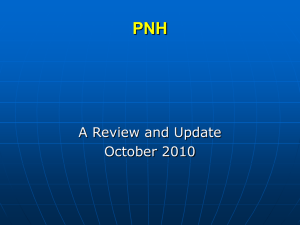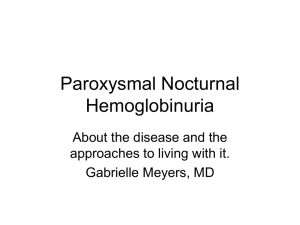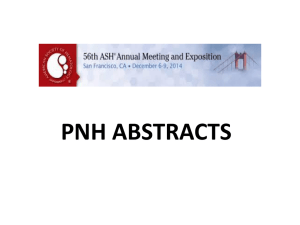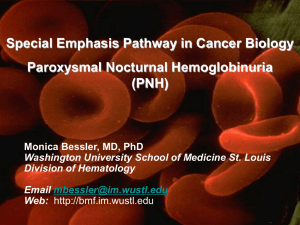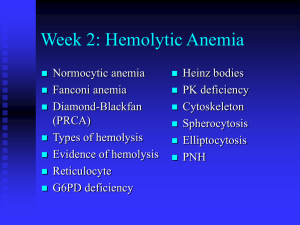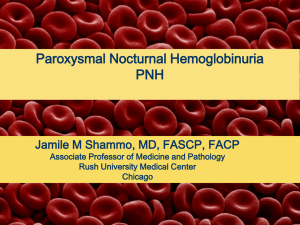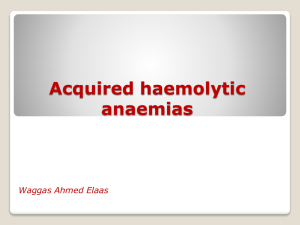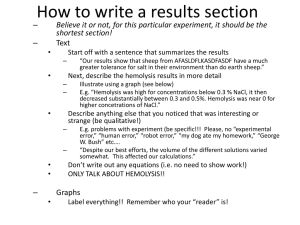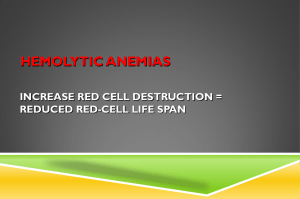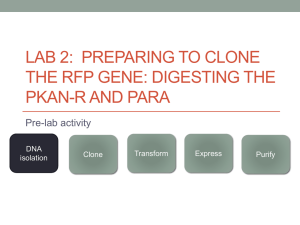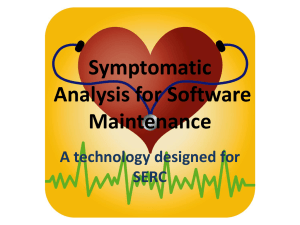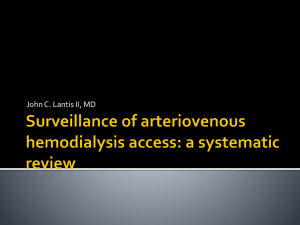Dr Tiu
advertisement
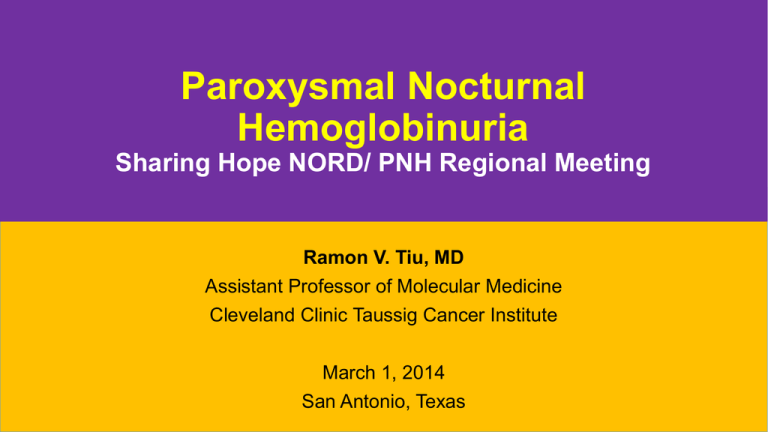
Paroxysmal Nocturnal Hemoglobinuria Sharing Hope NORD/ PNH Regional Meeting Ramon V. Tiu, MD Assistant Professor of Molecular Medicine Cleveland Clinic Taussig Cancer Institute March 1, 2014 San Antonio, Texas Objectives 1. Overview of PNH • Historical Background, Epidemiology of PNH, Pathogenesis of PNH, Clinical Manifestations in PNH, Classification of PNH 2. 3. 4. 5. 6. 7. Diagnosis of PNH Thrombosis in PNH Treatment of PNH Other Long term complications of PNH Updates in PNH Other Issues in PNH Overview of PNH Historical Background (selected timelines) • 1866 – Dr. William Gull published important observations on the clinical feature of PNH but did not distinguish it from paroxysmal cold hemoglobinuria • 1882 – paper of Dr. Paul Strubing that clearly described PNH and distinguished it from paroxysmal cold hemoglobinuria and mrch hemoglobinuria • 1939 – Dr. Thomas Hale Ham reported evidence that complement mediates abnormal lysis of PNH RBCs in acidified serum • 1950s – Louis Pillemir discovered the alternative pathway of complement • 1993 – Kinoshita and colleagues found that PNH is a consequence of mutant PIG-A gene Parker CJ. Hematol Am Soc Hematol Educ Program.2008 Overview of PNH Epidemiology of PNH • A type of bone marrow failure syndrome • A rare disease (1-2 per million annual rates) • However mortality rates in this disease is high Overview of PNH Genetic defect in PNH and effect on disease phenotype • Somatic mutation in the PIGA gene, rarely mutation in PIG-T gene • This leads to loss in GPI link proteins which anchors important proteins to the surface of cells • This results in absence of CD55 and CD59 which makes the RBC prone to hemolysis Krawitz Blood 2013. Luzzatto L Blood 2013;122:1099-1100 Overview of PNH The Complement Pathway Jozsi M. Book Chapter. An Update on Glomerulopathies. Overview of PNH Classification of PNH 3 groups 1. Classic PNH 2. PNH in the setting of a BM disorder (MDS, AA, MF) 3. Subclinical PNH – very small GPI negative clones with no obvious clinical significance (In this context, using the term PNH may be misleading since none of the clinicl manifestions of this condition are present. Some have proposed the term “acquired GPI-AP deficiency.” Parker CJ et al. Blood. 2005; Risitano A & Rotoli B. Biologics: targets & Therapy. 2008 Overview of PNH • • • • • • • • • Clinical Manifestations of Patients with PNH Thrombosis Fatigue Dysphagia Abdominal Pain Erectile dysfunction Pulmonary HTN Pain symptoms Other symptoms related to Anemi Other symptoms related to thrombocytopenia or neutropenia if these abnormalities are present Standard Diagnostic Test for PNH Flow cytometry performed on peripheral blood Granulocytes and at least one additional cell line should be evaluated – Red blood cells (RBCs) – Monocytes Quantitative results – Optimal-High sensitivity analysis: ≥0.01% – Routine analysis: ≥1% Easy to understand PNH reports Use more than one reagent against GPI-anchored proteins Borowitz MJ et al. for International Clinical Cytometry Society. Part B Clin Cytometry. 2010;78B:211-230. 9 Testing for PNH in Red Blood Cells Normal RBC’s with normal CD59 expression (Type I cells) PNH clone with complete CD59 deficiency (Type III cells) Gating on GPA+ RBC’s PNH clone with complete CD59 deficiency (Type III cells) and partial CD59 deficiency (Type II cells) GPA = glycophorin A. Data Source - Dahl-Chase Diagnostic Services. 10 Why Look Beyond RBCs for PNH? Granulocytes provide more accurate representation of PNH clone size Percentages of PNH RBCs may be affected by – Hemolysis – Blood transfusion PNH reports should provide quantitative results expressing clone size on both granulocytes and red blood cells Borowitz MJ et al. for International Clinical Cytometry Society. Part B Clin Cytometry. 2010;78B:211-230. 11 PNH Patient With an 80% WBC Clone Size and 31% RBC Clone Size Indicating Hemolysis RBC CD24- Granulocytes WBC FLAER- GPI Anchor Binding Marker 80.1 % of Granulocytes lack GPI proteins Data Source - Dahl-Chase Diagnostic Services. CD59 – GPI Anchored Protein 31.4% RBCs are Type III PNH cells 12 Important to Monitor Granulocytes and RBCs Over Time FLAER-GPI Anchor Marker Mar 09 FLAER-GPI Anchor Marker May 09 CD24-Granulocytes CD24-Granulocytes CD14-Granulocytes Dec 08 CD24-Granulocytes CD24-Granulocytes Sept 08 FLAER-GPI Anchor Marker FLAER-GPI Anchor Marker Gran clone: 3.8% Gran clone: 7.6% Gran clone: 14.2% Gran clone: 23.3% RBC clone: 0.8% RBC clone: 1.6% RBC clone: 1.8% RBC clone: 2.4% CD59 –GPI Anchor Protein CD59 –GPI Anchor Protein 3 Months CD59 –GPI Anchor Protein CD59 –GPI Anchor Protein 6 Months 9 Months PNH Clone Expanded in <1 Year 13 Diagnosis of PNH When to test • A patient with unusual sites of thrombosis especially in a young patient • Persistent coombs negative hemolytic anemia • A patient with aplastic anemia • Patient with unexplained cytopenias Thrombosis in PNH Frequency of blood clots in PNH • Thrombosis of arterial and venous blood vessels are common in PNH • Frequency of DVT/ PE (venous)= 40% • Frequency of strokes/ hearts attacks (arterial) = 15% • Major cause of death in 40-67% of PNH patients Hillmen P et al. Blood. 2007; Hill A et al . Blood. 2013. Thrombosis in PNH Location of blood clots in PNH DVT and Pulmonary embolism – But can occur anywhere in PNH most common types of blood clots in 1. Medscape reference website: http://emedicine.medscape.com/article/300901-overview#aw2aab6b2b2aa PNH 2. Mynyp.org website: https://mynyp.org/My_Health/tests/NonInvasiveFlowStudies.aspx Signs and symptoms suggestive of Thrombosis in the presence of a blood clot in a PNH PNH patient • Symptoms associated with blood clots (depends on the location) Limbs Lungs Deep Vein Thrombosis Pulmonary embolism • Swelling of the leg most of the time just one leg or one limb • sudden onset of difficulty breathing • Pain in one leg or one limb • Painful swelling of one leg or one limb • chest pain • coughing up blood • pain when taking a deep breath Signs and symptoms suggestive of Thrombosis in the presence of a blood clot in a PNH PNH patient • Symptoms associated with blood clots (depends on the location) Cerebral Vein Thrombosis Abdominal venous thrombosis • difficulty speaking • sudden onset of abdominal pain • difficulty in moving your limbs • abdominal bloating • weakness on one side of the body • rapid weight gain • blurring of vision • an enlarged spleen can indicate portal vein thrombosis • headaches Thrombosis in Proposed mechanisms of blood PNH clot formation in PNH • Activation of Platelets • Intravascular hemolysis: depletion of NO, toxicity of free hemoglobin, and red cell microvesicles • Deficiency or absence of other GPI-linked (or associated) proteins: uPAR, heparan sulfate, TFPI, and proteinase-3 • Other complement-mediated procoagulant mechanisms (independent of hemolysis) Hill A et al. Blood. 2013 Thrombosis in Tests used to identify bood clots in PNH PNH • Blood clots in the arms and lower extremity (deep vein thrombosis): duplex ultrasound • Blood clots in the lungs (Pulmonary embolism): Spiral CT of the chest, CT pulmonary angiography, pulmonary angiography, D-dimer, Echocardiography, Troponin T, Brain natriuretic peptide • Blood clots in the head (Central vein occlusion, strokes): CT scan or MRI of the head • Blood clots in the abdomen: US with flow or CT-scan of the abdomen/ pelvis • Blood clots in the heart (Angina or heart attack): EKG and cardiac enzymes Thrombosis in PNH Management of an acute/ recurrent thrombotic episode • Early management: • Start anti-coagulation in the form of unfractionated heparin or low molecular weight heparin (enoxaparin) • Maintenance with Coumadin • No data on the use of newer anti-coagulants in patients with PNH • Long Term management: • Consider initiating eculizumab therapy Thrombosis in PNH Management of Thrombosis prophylaxis • Prophylactic Coumadin (but risks and benefits must be carefully weighed) • There is no clear consensus on whether eculizumab should be started just on the premise of thrombosis prophylaxis • Can we safely stop anti-coagulation in a patient who had a history of blood clots Treatment in PNH Management of Hemolysis and anemia Brodsky R A Blood 2009;113:6522-6527 Treatment in PNH Eculizumab therapy (mechanism of action) Brodsky R A Blood 2009;113:6522-6527 25 26 27 28 29 30 Treatment in PNH Eculizumab therapy (Important reminders while on therapy) Recommendation for Persons Aged 2 Through 54 Years with Reduced Immune Response (ACIP guidelines 2010) Data indicate that the immune response to a single dose of meningococcal conjugate vaccine is not sufficient in persons with certain medical conditions. Persons with persistent complement component deficiencies (e.g., C5--C9, properidin, factor H, or factor D) or asplenia should receive a 2-dose primary series administered 2 months apart and then receive a booster dose every 5 years. Adolescents aged 11 through 18 years with HIV infection should be routinely vaccinated with a 2-dose primary series. Other persons with HIV who are vaccinated should receive a 2-dose primary series administered 2 months apart. All other persons at increased risk for meningococcal disease (e.g., microbiologists or travelers to an epidemic or highly endemic country) should receive a single dose. Advisory Committee on Immunization Practices 2010. Adverse Reactions Reported in ≥ 5% of SOLIRIS® Treated Patients in TRIUMPH Patients, n (%) Reaction SOLIRIS® (n=43) Placebo (n=44) Headache 19 (44) 12 (27) Nasopharyngitis 10 (23) 8 (18) Back pain 8 (19) 4 (9) Nausea 7 (16) 5 (11) Fatigue 5 (12) 1 (2) Cough 5 (12) 4 (9) Herpes simplex virus infections 3 (7) 0 Sinusitis 3 (7) 0 Respiratory tract infection 3 (7) 1 (2) Constipation 3 (7) 2 (5) Myalgia 3 (7) 1 (2) Pain in extremity 3 (7) 1 (2) Influenza-like illness 2 (5) 1 (2) SOLIRIS® (eculizumab) [package insert]. Alexion Pharmaceuticals; 2009. 32 Treatment in Management of Bone Marrow Failure PNH • Aplastic Anemia is a rare bone marrow failure syndrome • PNH and Aplastic Anemia can occur together in the same patient either at the original time of diagnosis or with PNH preceding the diagnosis of Aplastic Anemia or developing later in a patient with Aplastic Anemia • The co-occurrence of PNH and Aplastic Anemia can complicate the natural history of PNH and management Overview Epidemiology of AA • • Diagnosis of AA 2-4 per 1 million individuals per year (US) 2-3 fold higher in Asia • • • Hypocellular bone marrow (<30%) cytopenias normal karyotype by metaphase cytogenetics (In general) Decision to treat - Based on Disease Severity Moderate AA Severe AA Very Severe AA 1) <30% BM cellularity 1) <30% BM cellularity And depressed counts but did not reach criteria for severe AA And at least 2 of the ff: And at least 2 of the ff: Subset Chronic moderate AA: >3 months 1) 2) 3) 1) <30% BM cellularity ANC <0.5 x 109/L Plt count <20 x 109/L Retic count <60 x 109/L Needs Treatment ? 1) ANC <0.2 x 109/L 2) Plt count <20 x 109/L 3) Retic count <60 x 109/L Needs Treatment Natural Disease History by Disease Severity without treatment sAA and vsAA Moderate AA 0 1 2 3 Camitta B et al. Blood. 1976 Bacigalupo A et al. BJH 1988 4 5 6 7 Gluckman et al. BJH, 1982 8 9 10 Overview How to treat AA? Severe AA or Very Severe AA Age <40 years old With Matched Sibling Donor Bone Marrow Transplant Age ≥40 years old No Matched Sibling Donor Immunosuppression Non-Transplant Pharmacologic Treatments (sAA) Anti-Thymocyte Globulin/ Anti-Lymphocyte Globulin • Polyclonal purified IgG fraction of sera from animals like rabbit, horse or rarely goats that are immunized with human thymocytes or T cell lines • Mainstay in the treatment of severe AA or very severe AA • Combined with cyclosporine or tacrolimus for the treatment of AA • Results in 70-80% overall response rate in the frontline setting • Can be used in the salvage setting • Available as rabbit or horse Thymus T cell Lines Polyclonal IgG T cells B cells Monocytes Dendritic Cells/ APCs Mohty M & Gaugler B. Leuk & Lymph 2008 ATG + Cyclosporine G A Mechanism of Action B Virus Stem cells CD28 TCR Stem cells T cells APC Virus Cell-Cell Contact Unknown Antigens Virus Calcineurin Inhibitors •Cyclosporine •Tacrolimus Treatment Options C D T cell Activation Stem cells Effector Mechanisms Cellular Damage Depleting Agents • ATG/ALG E F IL-2, IL-4, IL-6 IL-1, IL-6 Naïve T cells Cytokine Release Activated T cells T cell Effector Differentiation T cells T cell Expansion Expanded Effector T cells Non-Transplant Pharmacologic Treatments (sAA) How can we improve these results? How 100can we improve these results? Strategies Employed 100 75 ATG + CsA 70-80% 75 1) Use a different ATG 90% 50 CsA ATG % + 60-80% ATG Alone 2) Add Additional Agents 25 40-50% % 50 ~35% 3) Use a completely different ~58% Agent/ Pathway ~10-15% 0 Response Rate ATG Alone Relapse Rate Clonal Evolution Overall Survival 25 40-50% ~35% ~6-15% 0 4 Goals in sAA Treatment 11 year follow-up Response Rate Relapse Rate Clonal Evolution Overall Survival Frickhofen N et al. Blood. 2003 Other Long term complications in PNH Clonal evolution to MDS/AML • A fairly sizable proportion of patients with aplastic anemia may later develop PNH (20-40%). • Patients with PNH may often have bone marrow failure and some will develop aplastic anemia. • Patients with PNH may develop myelodysplastic syndrome and or acute myelogenous leukemia (<5%). • Patients with MDS may have a small PNH clone present and these patients may respond better to immunosuppressive therapy with ATG and/or cyclosporine. Updates in PNH New information on disease pathogenesis • Genetic Variants in C5 lead to poor response to eculizumab in PNH • 345 Japanese patients (11 had poor response) • All 11 had a single missense C5 heterozygous mutation c2654GA predicting for a ;olymorphism pArg885His • Cannot undergo eculizumab blockade Nishimura JG et al. NEJM 2014 Updates in PNH New therapies on the horizon Compstatin/ Peg cp40 • A peptidic C3 inhibitor • A 13 residue cyclic peptide that specifically binds to C3 and C3b • Smaller protein molecule so has less likelihood of promoting antigenicity • Demonstrates dose dependent inhibition of hemolysis and opsonization • Impairs all initiation, amplification and terminal pathway of complement Risitano A et al. Blood. 2013 Updates in PNH New therapies on the horizon TT30 • It is a novel recombinant protein that is designed to control both intravascular and extravascular hemolysis of PNH RBCs. • It is a 65 kDa fusion protein consisting of the iC3b/C3dg-binding domain of complement receptor 2 (CR2; ie, the short consensus repeats [SCRs] 1-4), and the CAP inhibitory domain of factor H (fH; ie, SCR1-5), a complement inhibitor present in human blood whose primary role is to control fluid phase tickover • fH selectively inhibits the activation of CAP and the CAP C3 convertase, without affecting complement activation and C3 convertase activity arising from the classic pathway (CCP) and mannose/lectin (CMP) pathway. • fH both prevents formation and promotes the decay of the CAP C3 convertase and also prevents its formation by acting as a cofactor with factor I (fI) to cleave C3b into the inactive fragment iC3b. Risitano A et al. Blood. 2012 Complement cascade modulation on normal and PNH RBCs, with or without complement inhibitors. Risitano A M et al. Blood 2012;119:6307-6316 ©2012 by American Society of Hematology Other issues in PNH Pregnancy • 23 women: 19 with PNH, 4 with AA/PNH • 38 pregnancies • 11 miscarriages • Pregnancy: 6 hemolysis, 6 hemorrhage • Labor: 5 hemolysis, 3 hemorrhage, 1 thrombosis, 1 sepsis • No maternal deaths • Uncomplicated in one-third of pregnancies De Gramond et al., Lancet 1987;1:868 Other issues in PNH Surgery Use of blood thinners for a short period of time after completing surgeries that puts patients at high risk for blood clots (e.g. hip surgeries, knee surgeries). Certain patients with PNH accompanied by aplastic anemia may have lower ability to compensate for blood loss that occurs as part of the surgery and therefore close monitoring of counts and administration of appropriate transfusions may be necessary In a case of a patient who is undergoing cardiac surgery where extracorporeal machine is used. G-CSF administration and red blood pack transfusions, perioperative platelet substitution, fluid management, and antibiotic prophylaxis were utilized successfully 1. Knobloch K et al. Interactive Cardiovascular and Thoracic Surgery. 2003; 2(4):647-649. Conclusions PNH patients are at risk for thrombosis Eculizumab can decrease thrombotic events. Blood thinners are used to treat blood clots and can be used to prevent blood clots in certain circumstances Other potential long term problems in PNH includes kidney damage, hemolysisassociated pulmonary HTN, pain symptoms, fatigue, development of AA or MDS It is important to discuss with your PNH specialist any plans for pregnancy and surgery. The treatment for PNH has improved significantly over the years and this has lead to better outcomes and quality of life. There are a lot of new advances in the field of PNH that may lead to better therapies in the future THANK YOU
